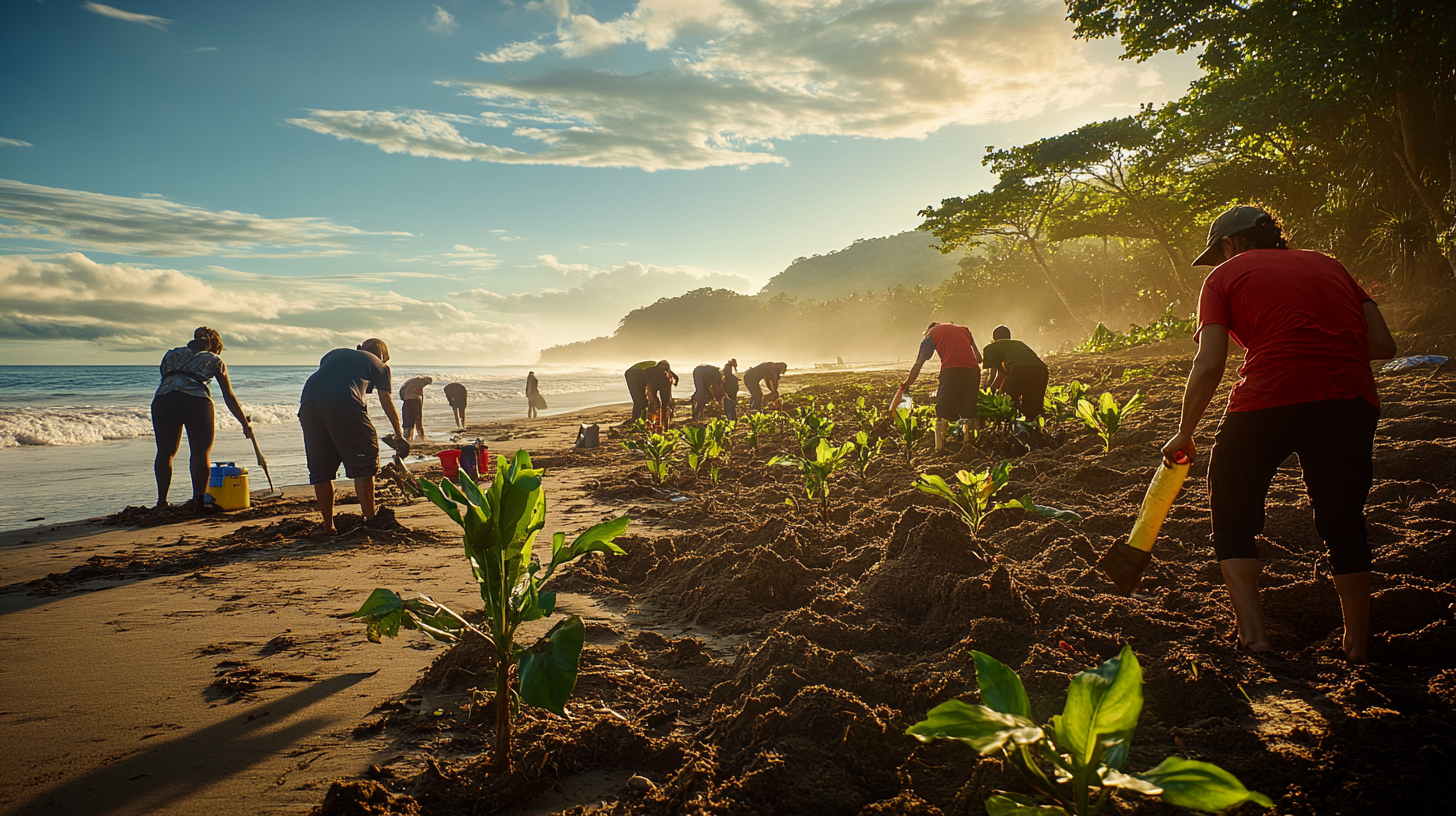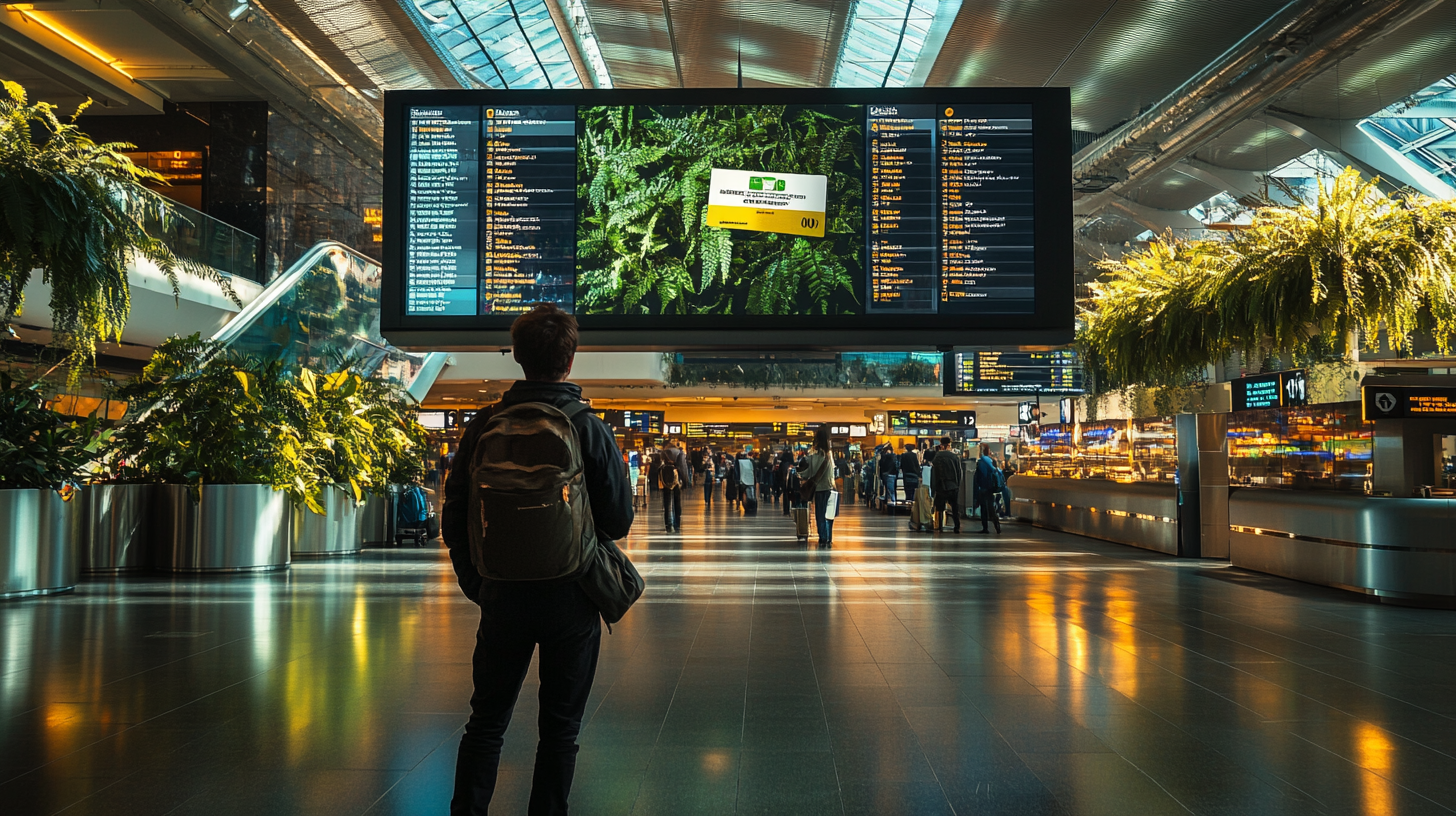The Green Mile: Eco-Conscious Travel Tips
From Carbon Offsets to Choosing Sustainable Airlines and Hotels, a Fun Yet Informative Guide to Going Green on the Go

Traveling the world is an enriching experience that broadens our horizons and connects us with diverse cultures. From wandering through ancient temples in Asia to savoring the culinary delights of Europe’s hidden gems, each journey shapes us in profound ways. However, it’s no secret that tourism can have significant environmental impacts, from carbon emissions due to flights to the strain on local resources in popular destinations. The good news is that eco-conscious travel doesn’t mean sacrificing comfort or adventure. In fact, it can enhance your travel experience by fostering deeper connections with the places and people you visit. Welcome to “The Green Mile,” where we explore practical, enjoyable ways to make your journeys more sustainable and leave a positive footprint wherever you go.
Understanding Sustainable Travel

Sustainable travel, also known as ecotourism, is all about making responsible choices that minimize negative impacts on the environment and support local communities. It’s not just a fleeting trend—according to recent studies, 87% of travelers are now prioritizing sustainability, seeking experiences that conserve natural resources and respect cultural heritage. This shift represents a growing awareness of our collective responsibility to protect the planet. By understanding what sustainable travel entails, we can all contribute to a healthier planet while enjoying the adventure of a lifetime.
Choose Eco-Friendly Transportation

Opt for Greener Modes of Travel

Transportation is one of the largest contributors to carbon emissions in the travel industry. Air travel alone accounts for about 2% of global emissions, and for frequent flyers, it can be the most significant part of their carbon footprint. To reduce this impact:
- Take Trains or Buses: Whenever possible, choose trains or buses over flights. Traveling by train not only reduces your carbon footprint but also allows you to enjoy scenic routes and local landscapes that you might otherwise miss at 30,000 feet. The Swedish concept of “flygskam,” or “flight-shaming,” has encouraged many to make this switch, leading to a resurgence in train travel across Europe. For instance, the high-speed rail network in Europe connects major cities efficiently, making overland travel both practical and enjoyable.
- Choose Eco-Friendly Airlines: If flying is unavoidable, opt for airlines that use biofuels or have strong sustainability programs. For example, Alaska Airlines has invested in renewable jet fuels and has implemented measures to reduce waste on flights. Additionally, airlines like KLM are exploring innovative technologies to reduce emissions. Researching and choosing such airlines can significantly reduce the environmental impact of your flights. Consult a comprehensive list of eco-friendly airlines to make informed decisions.
- Fly Economy and Non-Stop: Flying economy class shares the carbon cost among more passengers, making it a more sustainable choice. Moreover, choosing non-stop flights reduces emissions associated with takeoffs and landings, which are the most fuel-intensive parts of a flight. By planning ahead and booking direct flights, you not only save time but also contribute to lower overall emissions.
- Use Hybrid or Electric Vehicles: When renting cars, opt for hybrid or electric models if available. Rental companies like Hertz and Avis are increasingly offering electric vehicle options, making it easier to reduce your carbon footprint on the road. Driving an electric vehicle not only cuts emissions but also provides a quieter, smoother ride. Be sure to plan your route considering charging station availability, which is expanding rapidly in many countries.
- Embrace Public Transport and Biking: Explore cities using public transportation systems, which are often efficient and affordable. Many cities offer bike-sharing programs, such as Citi Bike in New York City , providing a healthy and eco-friendly way to see the sights. For example, cities like Amsterdam and Copenhagen are famous for their cycling culture, offering extensive bike lanes and facilities. Walking is also a great option, allowing you to discover hidden gems and interact with locals, all while reducing your emissions.
Consider Carbon Offsetting

Even with careful planning, some emissions are unavoidable. Carbon offsets allow you to compensate for the emissions by funding projects that reduce carbon elsewhere:
- Calculate Your Emissions: Use online calculators like TerraPass or Carbon Footprint to understand your travel footprint. These tools consider factors such as flight distance, type of aircraft, and class of travel to provide an estimate of your carbon emissions. By knowing your impact, you can make informed decisions on how much to offset and which projects to support.
- Choose Reputable Offset Programs: Support projects verified by organizations like the Climate Action Reserve or Verified Carbon Standard. Reputable programs ensure that your contributions are effectively reducing emissions, whether through renewable energy projects, reforestation, or methane capture initiatives. For example, funding a wind farm project can help replace fossil fuel energy with clean, renewable power. Consider supporting investing in reforestation projects to combat climate change as a highly effective way to offset your emissions.
- Offset Through Airlines: Airlines such as Delta offer offset programs, although participation rates are currently low. When booking your flight, look for options to add a carbon offset, which often supports projects aligned with the airline’s sustainability goals. Participating directly through the airline can simplify the process and encourage more companies to offer such programs.
- Support Local Conservation Efforts: Beyond offsets, contribute to tree-planting initiatives or conservation projects at your destination. Engaging with local environmental organizations not only offsets your emissions but also supports the community. For instance, volunteering for a day with a local conservation group can provide a meaningful experience while making a tangible difference. Websites like a directory of local conservation initiatives worldwide can help you find opportunities to get involved.
Select Sustainable Accommodations

Stay at Eco-Certified Hotels

Your choice of accommodation can significantly impact the environment. Many hotels now prioritize sustainability without compromising on luxury:
- Look for Eco-Certifications: Choose hotels with certifications like LEED (Leadership in Energy and Environmental Design) or B Corp, which indicate adherence to strict environmental standards. These certifications cover aspects such as energy efficiency, water conservation, sustainable site development, and indoor environmental quality. By selecting certified accommodations, you support businesses committed to environmental stewardship. Consulting a guide to sustainable hotel certifications can help you identify hotels that meet high environmental standards.
- Examples of Sustainable Hotels: Consider stays at properties like Hyatt, Hilton, Caribe Royal Orlando, or Hotel Xcaret, known for their eco-friendly practices. For instance, Hotel Xcaret in Mexico integrates natural and cultural resources into its design, promoting conservation and social responsibility. These hotels often implement initiatives like sourcing local food, using renewable energy, and reducing single-use plastics—all while providing exceptional guest experiences. Explore top-rated eco-friendly hotels worldwide to find accommodations that align with your sustainability values.
- Renewable Energy and Waste Reduction: Opt for accommodations that use renewable energy sources, such as solar or wind power, and have robust waste reduction programs. Many hotels are implementing recycling programs, composting organic waste, and reducing water usage through efficient fixtures. For example, some properties participate in initiatives like EarthCheck or Green Key, which benchmark their environmental performance. Staying at such places ensures your lodging minimizes its ecological impact.
Support Local Economies

Sustainable travel also means contributing positively to the communities you visit:
- Eat Local: Dine at local eateries to enjoy authentic cuisine and support local farmers and chefs. Visiting farmers’ markets and street food stalls not only provides a taste of the local culture but also reduces the environmental impact associated with importing food. Savoring dishes made from locally sourced ingredients can be an unforgettable part of your travel experience.
- Hire Local Guides: Enrich your experience with the knowledge of local guides while contributing to the local economy. Local guides can offer unique insights into the culture, history, and hidden gems of the area. They often have stories and perspectives that you won’t find in guidebooks, making your trip more meaningful. Additionally, your support helps sustain their livelihood and preserves traditional knowledge.
- Shop Responsibly: Purchase souvenirs from local artisans rather than mass-produced items. Buying handcrafted goods supports the artisans’ craft and helps maintain cultural traditions. Whether it’s a handwoven textile, a piece of local artwork, or traditional jewelry, these items carry the story and spirit of the place. Always be mindful of what you’re purchasing to avoid contributing to the exploitation of wildlife or cultural artifacts. To find authentic local experiences, consider using platforms connecting travelers with local communities .
Pack Light and Reduce Waste

Travel Light

Packing minimally reduces the weight of transportation, which in turn lowers fuel consumption and emissions:
- Essentials Only: Bring only what you need. This not only reduces weight but also simplifies your travel experience. A lighter suitcase means less hassle navigating airports and public transportation. Additionally, lighter luggage contributes to lower emissions, as airplanes and vehicles use less fuel when carrying less weight. Remember, you can often do laundry during your trip or purchase necessities locally.
- Eco-Friendly Products: Use biodegradable toiletries and products with minimal packaging. Switching to solid shampoo bars, biodegradable soaps, and refillable containers can significantly reduce plastic waste. Moreover, choosing products that are safe for the environment ensures that you’re not introducing harmful chemicals into local ecosystems, especially important when visiting sensitive natural areas. For tips on sustainable packing, explore an eco-friendly travel packing checklist .
Minimize Single-Use Plastics

Reduce waste by avoiding single-use plastics and embracing reusable alternatives:
- Carry Reusable Items: Bring a reusable water bottle, shopping bag, and utensils. Many countries have safe drinking water readily available, and carrying a reusable bottle helps avoid plastic waste. A foldable shopping bag is handy for carrying purchases and prevents the need for plastic bags. Reusable utensils, such as bamboo cutlery, are lightweight and convenient for meals on the go.
- Say No to Straws: Politely decline plastic straws and other disposables offered at restaurants and cafes. If needed, bring your own reusable straw made from stainless steel or bamboo. Small actions like this can significantly reduce plastic pollution, especially in countries where waste management infrastructure may be lacking.
- Proper Waste Disposal: Dispose of trash responsibly, recycling whenever possible. Familiarize yourself with the recycling practices at your destination, as they may differ from your home country. In some places, you may need to hold onto recyclables until you find appropriate disposal facilities. Always avoid littering, and consider participating in local clean-up efforts. To learn more about reducing plastic waste while traveling, consider checking strategies for a zero-waste travel experience .
Engage Responsibly with Destinations

Respect Local Cultures and Environments

Being mindful of your actions can lead to more meaningful travel experiences:
- Adhere to Guidelines: Follow local regulations and customs to show respect and avoid unintended harm. This includes observing dress codes at religious sites, respecting photography restrictions, and complying with environmental regulations such as staying on designated trails. Learning a few phrases in the local language can also go a long way in showing respect.
- “Take Only Photos, Leave Only Footprints”: Avoid removing natural items or disturbing wildlife habitats. Collecting shells, rocks, or plants can harm local ecosystems. Stick to designated paths to prevent soil erosion and protect plant life. Wildlife should be observed from a distance without feeding or interacting with animals, as this can alter their natural behaviors.
- Avoid Over-Tourism: Visit less-traveled destinations or travel during off-peak times to reduce pressure on popular sites. Over-tourism can lead to environmental degradation, strain on local infrastructure, and diminished visitor experience. Exploring lesser-known locations not only benefits the environment but can also provide unique and authentic experiences away from crowds. For ideas on alternative destinations, explore a list of sustainable travel destinations off the beaten path .
Participate in Conservation Activities

Give back to the places you visit:
- Volunteer Opportunities: Join local conservation projects or community initiatives. Volunteering can range from a one-day beach clean-up to a longer commitment like wildlife monitoring. Not only does this help the environment, but it also enriches your travel experience through meaningful interactions. Ensure that the programs are reputable and genuinely benefit the community. To find reputable volunteering opportunities, consult a directory of ethical wildlife and conservation volunteering programs .
- Eco-Tours: Choose tours that focus on sustainability and education, such as those offered by Royal Caribbean. Eco-tours emphasize responsible travel practices, environmental education, and cultural sensitivity. They often include activities like guided nature walks, wildlife observation, and cultural exchanges that are designed to be low-impact and beneficial to local communities.
- Support Regenerative Tourism: Engage in activities that restore and enhance ecosystems and communities. Regenerative tourism goes beyond sustainability by actively improving the destinations visited. This could involve participating in reforestation projects, supporting social enterprises, or contributing to community development initiatives. By doing so, travelers can leave places better than they found them.
Be Aware of Greenwashing

Not all “eco-friendly” claims are genuine. Stay informed to make responsible choices:
- Research Brands and Services: Investigate companies to ensure their sustainability practices are authentic. Look beyond marketing slogans and seek out evidence of real environmental actions. Check for certifications, read reviews, and examine their sustainability reports if available. Be wary of vague claims without substantiation.
- Look for Transparency: Companies that are truly committed to sustainability will provide clear and detailed information about their efforts. This includes measurable goals, progress reports, and willingness to discuss challenges. Transparency builds trust and ensures that your choices genuinely support eco-friendly practices. For tips on how to spot greenwashing, read an in-depth guide to recognizing genuine sustainability efforts in the travel industry .
Embrace Technology for Sustainable Travel

Use technology to enhance your eco-travel experience:
- Use Apps for Planning: Find apps that help you locate sustainable accommodations, restaurants, and activities. Applications like HappyCow can guide you to vegetarian and vegan dining options, while others like Ecobnb specialize in eco-friendly lodging. Utilizing these tools makes it easier to align your travel choices with your sustainability goals. For a comprehensive list of sustainable travel apps, check out the best apps for eco-conscious travelers .
- VPN for Cybersecurity: Protect your data while accessing public Wi-Fi, and potentially find better travel deals. Using a VPN (Virtual Private Network) secures your connection and safeguards sensitive information like banking details. Additionally, VPNs can allow you to compare prices from different regions, sometimes resulting in cost savings on bookings.
- Travel Credit Cards: Consider cards that offer rewards aligned with sustainable travel choices. Some credit cards provide points or cash back for spending on eco-friendly products and services. Researching and selecting a card that promotes sustainability can enhance your commitment to responsible travel. To find out which credit cards support sustainable spending, refer to a guide to eco-friendly travel rewards credit cards .
The Role of Slow and Purposeful Travel

Slowing down can lead to richer experiences and reduced environmental impact:
- Stay Longer in One Place: Immerse yourself in the local culture and reduce the frequency of travel-related emissions. By spending more time in one location, you minimize the need for additional transportation, which reduces your carbon footprint. This approach allows you to delve deeper into the local way of life, traditions, and customs, leading to a more authentic experience.
- Connect with Communities: Build relationships and contribute more significantly to the local economy. Engaging with residents can lead to meaningful exchanges and insights that typical tourism often misses. Participating in community events, workshops, or language classes enhances mutual understanding and supports local businesses.
- Reduce Stress: A slower pace allows for a more relaxed and fulfilling journey. Instead of rushing from one attraction to another, taking the time to savor each experience can improve your well-being. This mindful approach to travel promotes personal growth and a deeper appreciation of your surroundings. For more on the benefits of slow travel, see how slow travel enhances sustainability and personal growth .
Join the Movement Toward Sustainability

The shift toward eco-conscious travel is gaining momentum, supported by travelers, businesses, and even public figures like Prince Harry and Greta Thunberg. For instance, Greta’s transatlantic voyage on a zero-emissions yacht highlighted the possibilities of sustainable transportation. Companies are responding to this demand by offering more sustainable options, such as airlines investing in biofuels and hotels implementing energy-saving technologies. Technology is making it easier than ever to make informed choices, with resources at our fingertips to guide sustainable decision-making.
By incorporating these tips into your travel plans, you can enjoy incredible experiences while ensuring that your adventures contribute positively to the planet and its people. Remember, sustainable travel isn’t just about reducing negative impacts—it’s about enhancing the places we visit and preserving them for generations to come. As more individuals commit to responsible travel, the collective impact can lead to significant environmental benefits and a more equitable world. Every journey is an opportunity to make a difference. For more stories on the impact of sustainable travel, read case studies showcasing the benefits of eco-tourism .
Final Thoughts
Eco-friendly travel is not just a responsibility; it’s an opportunity to deepen your connection with the world. By embracing sustainable practices, you not only protect the environment but also enrich your own experiences. Every conscious decision, from the transportation you choose to the souvenirs you buy, makes a difference. It’s about being mindful of your impact and finding joy in choices that benefit the planet and its inhabitants.
Follow us back to milesBUZZ for more insights and tips on sustainable travel. Embark on your adventure with purpose and passion. Happy travels on your Green Mile!







